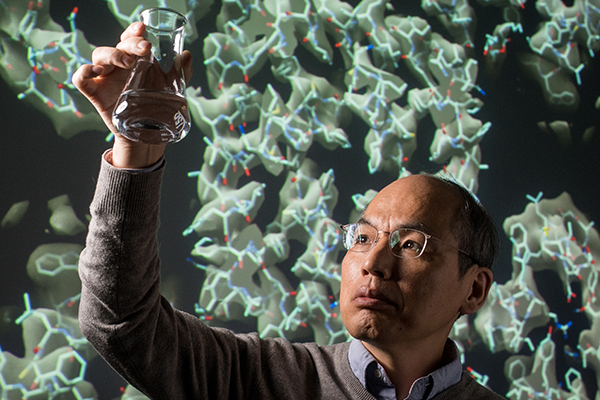
How our bodies sense our environment and react to it is a big question, and how we answer it can have important implications for drug development. That’s why Seok-Yong Lee, PhD, professor of biochemistry and cell biology at the Duke School of Medicine, has been on a quest to understand how our bodies sense and respond to temperature. Specifically, Lee studies ion channel activation and its role in our sensitivity to cold through temperature and menthol and hot through temperature and capsaicin.
For example, our eyes tear up when they sense cold air. Behind the scenes, the ion channel TRPM8 activates in response to cold and sends a signal to increase tear production to keep the eyes moist. Activating this channel through medicine could help treat health issues like dry eye, a condition in which tears can’t produce enough lubrication to keep the eyes wet. The same ion channel activates and triggers an anti-inflammatory response when you apply an ice pack to a bump or bruise.
Lee, a Duke Science and Technology Scholar, has a long history researching ion channel activation, beginning with his postdoctoral work at Rockefeller University under Roderick MacKinnon, MD, who won the 2003 Nobel Prize in Chemistry for his work on the structure and operation of ion channels. Lee started his own lab at Duke in 2009 to investigate ion channel activation for hot and cold sensations. He published his first paper on TRPM8 in 2017, a second in 2019, and another in 2022, all in the journal Science.
“Understanding how these channels operate means that we understand how humans sense hot and cold temperature changes, which is a fascinating problem to solve,” said Lee.
Lee attributes much of his success to Duke’s Cryogenic electron microscopy (Cryo-EM) capabilities, which have allowed him and his team to observe ion channels in extraordinary detail. They have observed that the shape of the TRPM8 ion channel pore changes completely in response to temperature variations. Initially, it looks wide and unpore-like, but as a cooling stimulus is introduced, the pore gradually changes shape to allow ions to pass through, which activates the neurons responsible for sensing cold.
“I’ve never seen this in other types of ion channels,” Lee said. “I speculate that this unique activation process underlies TRPM8’s sensitivity toward both physical cold and chemical menthol stimuli.”
With hi-resolution, 3D structures in hand, pharmaceutical companies can determine how to design smarter and more targeted drugs to activate ion channels for therapeutic applications. Lee has been working closely with one pharmaceutical company for over two years through the Duke Sponsored Research Program.
How will Lee’s next chapter be written? “The scientific question is unclear, but I know I want to be involved in translating my research for the good of human health,” he said. “So, I will continue studying these temperature-activated channels for a while.”